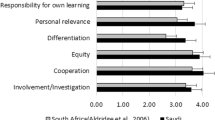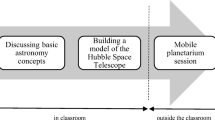Abstract
This study investigated students’ perceptions of the generalist learning environment of the primary school compared to their perceptions of the specialist science learning environment of secondary school. The role of student gender and change in school size as influencing factors on changes in students’ perceptions across primary to secondary transition were especially considered. The same students’ perceptions of the learning environment were collected in the final stages of primary school and again after their initial term in secondary school. Insights were gained into how students’ perceptions of learning environment changed during their first exposure to specialised science learning environments and teachers, and how these changes in perceptions during transition depended upon school size and student gender. Both school size and student gender were found to be influencing factors for changes in some learning environment dimension perceptions.
Similar content being viewed by others
References
Baird, J. R., Gunstone, R. F., Penna, C., Fensham, P. J., & White, R. T. (1990). Researching the balance between cognition and affect in science teaching and learning.Research, in Science Education 20, 11–20.
Barker, R. G., & Gump, P. V. (1964).Big school, small school. Stanford, CA: Stanford University Press.
Blyth, D. A., Simmons, R. G., & Bush, D. M. (1978). The transition into early adolescence: A longitudinal comparison of youth in two educational contexts.Sociology of Education, 51, 149–162.
Cotterell, J. L. (1992). School size as a factor in adolescents’ adjustment to the transition to high school.Journal of Early Adolescence, 12(1), 28–45.
Department of Employment, Education, Training and Youth Affairs (DEETYA). (1996).Ending Alienation. The Gender Equity Network (June Edition) (pp. 1–4). Australian Capital Territory: Department of Employment, Education, Training and Youth Affairs (DEETYA).
Feldlaufer, H., Midgley, C., & Eccles, J. S. (1988). Student, teacher, and observer perceptions of the classroom environment before and after the transition to junior high school.Journal of Early Adolescence, 8, 133–156.
Ferguson, P. D., & Speering, W. (1997). “Great expectations: Grim realities.” Secondary school initiates perceptions of science.Proceedings of the 1997 International Conference on Science, Mathematics and Technology Education (pp. 189–198), Hanoi, Vietnam.
Fisher, D. L., & Fraser, B. J. (1981). Validity and use of My Class Inventory.Sciece Education, 65, 145–156.
Fisher, D. L., Fraser, B. J., & Rickards, T. (1997, April).Gender and cultural differences in teacher-student interpersonal behaviour. Paper presented at the annual meeting of the American Educational Research association, Chicago, Ill.
Fraser, B. J. (1994). Research on classroom and school climate. In D. Gabel (Ed.),Handbook of research on science teaching and learning (pp. 493–541). New York: Macmillan.
Fraser, B. J., (1998). Science learning environments: Assessments, effects and determinants. In B. J. Fraser, & K. G. Tobin (Eds.),International handbook of science education (pp. 527–564). Dordrecht, The Netherlands: Kluwer Academic Publishers.
Fraser, B. J., & Walberg, H. J. (Eds.) (1991).Educational environments: Evaluation, antecedents and consequences. Oxford: Pergamon Press.
Hirsch, B. J., & Rapkin, B. D. (1987). The transition to junior high school: A longitudinal study of self-esteem, psychological symptomatology, school life, and social support.Child Development, 58, 1235–1243.
Jarman, R. (1990). Primary science-secondary science continuity: A new era?School Science Review, 71, 19–29.
Kelly, A. (Ed.). (1987).Science for girls? Milton Keynes: Open University Press.
Lawrenz, F. (1987). Gender effects for student perception of the classroom psychosocial environment.Journal of Research in Science Teaching, 24, 689–697.
Midgley, C., Eccles, J. S., & Feldlaufer, H. (1991). Classroom environment and the transition to junior high school. In B. J. Fraser, & H. J. Walberg (Eds.),Educational environments: Evaluation, antecedents and consequences (pp. 131–139). Oxford: Pergamon Press.
Oakes, J. (1990). Opportunities, achievement, and choice: Women and minority students in science and mathematics. In C. B. Cazen (Ed.),Review of research in Eeucation,. Washington, DC: American Educational Research Association.
Power, C. (1981).Changes in students in the transition between primary and secondary school. Canberra: Australian Government Publishing Services.
Power, C., & Cotterell, J. L. (1981).Changes in students in the transition from elementary to high school. Canberra: Australian Government Publishing Service.
Simmons, R. G., & Blyth, D. A. (1987).Moving into adolescence: The impact of pubertal change and school context. Hawthorn, NY: Aline de Gruyler.
Simmons, R. G., Burgeson, R., Carlton-Ford, S., & Blyth, D. A. (1987). The impact of cumulative change in early adolescence.Child Development, 58, 12220–1234.
Speering, W., & Rennie, L. J. (1996, April).Transition to secondary school: The impact of curriculum changes on students’ perceptions of science. Paper presented at the annual general meeting of the American Educational Research Association, New York.
Terwel, J., Brekelmans, M., Wubbels, T., & van den Eeden, P. (1994). Gender differences in perceptions of the learning environment in physics and mathematics education. In D. L. Fisher (Ed.),The study of learning environments (Vol. 8, pp. 39–51). Perth: Curtin University of Technology.
Tobin, K., & Garnett, P. (1987). Gender related differences in classroom processes in science activities.Science Education, 71, 91–103.
Wubbels, T., Brekelmans, M., & Hermans, J. (1987). Teacher behavior: An important aspect of the learning environment. In B. J. Fraser (Ed.),The study of learning environments (Vol. 3, pp. 10–25). Perth: Curtin University of Technology.
Wubbels, T., & Levy, J. (Eds.) (1993)Do you know what you look like? Interpersonal relationships in education. London: Falmer Press.
Author information
Authors and Affiliations
Corresponding author
Rights and permissions
About this article
Cite this article
Ferguson, P.D., Fraser, B.J. Student gender, school size and changing perceptions of science learning environments during the transition from primary to secondary school. Research in Science Education 28, 387–397 (1998). https://doi.org/10.1007/BF02461506
Issue Date:
DOI: https://doi.org/10.1007/BF02461506




